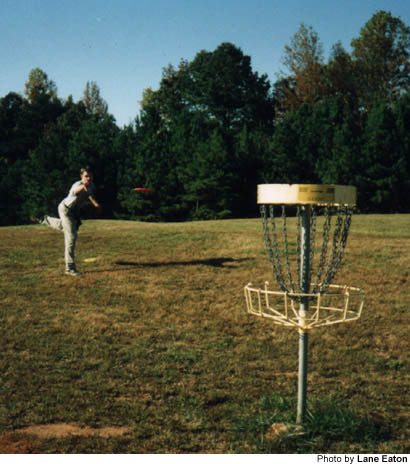
November 2, 1999 — When Lane Eaton told me that he had forgotten his putter, I knew I had severely underestimated the seriousness of disc golf.
Putter? I thought this sport was played with a Frisbee.
Well, plain old Frisbees are for kids, I learned. Adults hurl plastic discs with names like Cyclone, Viper and Gazelle.
Some discs are drivers, some are putters, others are for mid-range shots. Some discs are designed to roll when they hit the ground, others to hook or slice around trees.
There’s even a PDGA Tour with tournaments that pay out thousands of dollars.
This disc golf is serious stuff. I don’t know why I was surprised, but I was. Nothing should surprise me anymore. I’ve seen grown men go gaga over racing riding lawn mowers.
Like many fringe sports, disc golf originated in California during the 1970s — and I wouldn’t be surprised if marijuana was somehow involved in the process.
The rules are basically the same as “ball golf,” just substitute the ball with a plastic disc and the holes with elevated metal baskets.
Sound strange? Perhaps it is. Although some would argue that hitting around a little dimpled ball with a metal club sounds pretty darn strange as well.
I arrived at the disc golf course at Lake Russell State Park in Elberton not knowing what to expect. I left trying to decide how many discs I wanted to purchase with my first order.
“It is addicting,” said Eaton, 38, Lake Russell’s assistant park manager, who started playing when the park’s course was completed two years ago. “I play two or three times a week now.”
There are 11 disc golf courses in Georgia, several of which are in the greater Atlanta area. Lake Russell is the only state park to have one.
And many of Lake Russell’s visitors aren’t quite sure what to make of the metal baskets that dot the park’s landscape.
Some folks figure the contraptions are there to feed the park’s deer or wild turkeys. Eaton stopped one family preparing to use one of the baskets as a barbecue grill.
Yes, disc golf has a ways to go before it hits the mainstream.
But Eaton is doing his best to change that. He regularly conducts disc golf demonstrations in and around Elberton and he helped organize the first Lake Russell Open, which attracted 73 participants back in September.
“A lot of our local people like it because they can just let their stress out,” Eaton explained as we approached the course. “They can just wing that thing as hard as they can.”
The course itself — with rolling hills, countless trees and a large pond — is beautiful, especially now with the leaves changing colors. But beauty and hazard are closely related. Many an errant disc have ended up lodged among branches or floating in the drink.
The distance from “tee” to basket is measured in feet, and holes at Lake Russell range anywhere from 211 to 435. There are no disc golf carts either, so the experience can be as aerobic as you’d like it to be.
An average round takes between 60 and 90 minutes.
“People are willing to drive an hour to play this game, because it doesn’t take but an hour and a half to play,” said Eaton. “You can play two rounds of 18 in the length of time it takes you to play one round of ball golf. Most people that come here play two rounds.”
There is another reason people are willing to travel long distances to play disc golf. It’s cheap. How cheap? Well, it costs exactly $1 to play a round at Lake Russell, and that is relatively expensive in the world of disc golf. Most parks don’t charge a penny.
Discs range in price from $6 to $10. A beginner can get away with using just one, although most players like to carry a decent assortment in their disc bag.
Eaton is a good disc golfer. He regularly shoots rounds of 56 or better on Lake Russell’s course. His best is a 48. Par is 64. It probably helps that one of the state’s nicest courses is basically in his back yard.
During our round Eaton was constantly yelling at the discs: Roll! Stop! Hit a tree! Get down! Get there! Hit the basket! Drop! Get left!
I wonder if he does the same when he is alone on the course. He might as well; it seemed to work. He shot a 3-under 61 ‹ and that was without a putter.
I threw a bunch of knuckleballs and hit a good many trees en route to my 18-over 82. But I got progressively better as the round went on.
I threw my first par on the seventh hole and what happened on lucky No. 13 got me hooked.
It was my second shot on the par-3, 267-foot hole and I stood about 130 feet away from the basket. I let fly a straight screamer. Eaton helped cheer it along.
“Not bad! Get in!” he yelled.
Clang! My disc connected directly with the goal’s chains and settled into the basket. Eaton and I turned to each other, eyes and mouths agape in disbelief, and started to scream.
“Whoa!” Eaton exclaimed as we high-fived each other. “Alright, birdie man! Wasn’t that a neat feeling?”
Yes, it was a neat feeling — one that I plan on experiencing again. When I got home that evening I immediately logged on to the Internet and purchased my first four golf discs.
Finally, a sport that journalists can afford.
